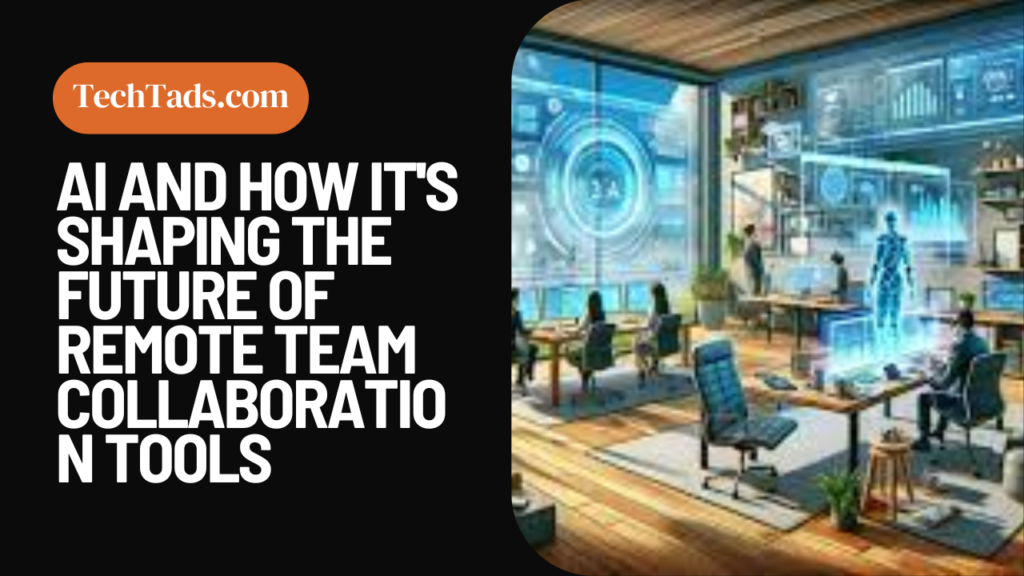In this fast-evolving digital world, remote work has become more than a short-term means of working. It has become part of business activities globally.
As the expanding corporate world accepts such changes, the need for efficient remote collaboration technologies has multiplied. As the power transformer, AI is crucial in transforming the technologies above and improving remote team communication, collaboration, and effectiveness.
Now, let’s see how AI is changing the future of online work and creating a smoother, more innovative, and more effective virtual workplace where people work together.
The Role of AI in Enhancing Remote Collaboration

From a buzzword, Artificial Intelligence has come to represent a force revolutionizing the face of our working world. Through AI, new channels to modern tools and functionalities open avenues to enhancing remote cooperation that works rather than hampers collaboration.
Artificial intelligence (AI) will be included in a remote work toolkit. It performs various functions, from automating routine chores to acquiring comprehensive insights into team dynamics.
Virtual Collaboration Tools
AI-based collaboration tools such as:
- Figma and Miro: These tools allow virtual teams to work together in real-time without sharing a particular geography. It supports easy-to-organize design and ideation meetings and uses AI to suggest elements and layouts in design and enhancement recommendations. The use of AI in the virtual whiteboard enhances creativity for teams that are remotely located. Improved Communication By Using AI
- Slack and Microsoft Teams: AI-powered chatbots and communication tools that provide indispensable solutions for remote work. These remote team collaboration tools use artificial intelligence to ease communication by automatically prioritizing all critical messages while answering routine questions. This allows remote employees to focus on more relevant business duties rather than getting carried away by minute details. AI can improve video conferencing systems by offering live transcriptions and translations, making communication across borders inclusive and efficient.
Enabling Human Capabilities
Although ChatGPT was welcomed dramatically, evidence shows that AI is unlikely to eliminate millions of jobs but augment human capabilities and transform jobs, ensuring better team performance.
An example is remote work, especially project management. AI has brought the predictive analytics of team productivity, staff availability, and procedural bottlenecks to entirely virtual work that was once traditionally tied to efficiency concerns. Remote leaders can speedily optimize resource allocation without micromanaging anything.
But productivity is low-hanging fruit for AI and remote work synergy. AI must be leveraged for innovation. It removes communication channels to give ideas as quickly as they arise. Companies have found it challenging to substitute in-office cooperation, where a stroll to the water cooler may initiate a conversation. Technologies powered by AI could automatically exchange cross-channel information or extract critical insights from video calls continuously.
AI-Driven Scheduling and Task Management
Time management is probably the biggest problem when working remotely; this is where AI can help. AI can automate the schedule of meetings, identify differences in time zones, and find the optimal slots for the team to collaborate.
For example, Google Calendar’s AI-powered integration can suggest the best times for a meeting based on the availability of remote teams to keep them well-organized and efficient.
Similarly, AI task management systems like Asana and Trello prefer scheduling to enhance workflows. Workers get extra time for high-value tasks rather than being swamped by routine work. AI optimizes the patterns of task execution to increase the team’s productivity.
AI analytics improves decision-making.
AI contributes to remote team data-driven decisions by bringing cognitive insights. Packages like Microsoft Power BI and Tableau use AI for multiple data analysis sources and deliver invaluable insights. AI could provide raw data or patterns followed by a prediction of results while sometimes recommending future steps based on previous results.
Remote team collaboration allows team members to make more informed decisions whenever they are not in the same room. AI enables a workplace to be on high alert and nimble by providing leaders with a candid view of the team’s progress, impediments, and opportunities.
Improved Security
Public WiFi networks, personal computers, and unmonitored browsing activity increase the number of potential entry points for fraudsters. Only a few security officers believe hybrid and remote work damages their organization’s security posture. However, IT support can’t be provided around the clock; the demand for cybersecurity professionals far outstrips the supply.
Such tools utilize AI to make working safely from home more accessible. AI is also used today in cybersecurity systems to look for real-time security holes in network data and spot fishy behavior. This lets businesses know if danger is close.
The benefits of AI for security are also in continuous growth. With time, it can strengthen security because it learns from users’ past activities, possible risks, and so on, as it will always learn something new. This makes me think that working from home might not go away soon.
Future Trends in AI and Remote Collaboration Technologies

AI can reveal the emotion and mood in any team interaction, revealing unhappy, disengaged, or overloaded employees. This could be instrumental in augmenting the extent of aid to mental health and well-being, especially in remote places where emotion is difficult to assess.
Alternatively, AI can automate team collaboration systems that could monitor project calendars, resource allocation, communication, and decision-making. This will subsequently allow teams to act with minimal interference from their managers and thus increase effectiveness.
AI can combine with AR and VR to create virtual offices where teams from remote locations may interact as if they were there. AI avatars and virtual whiteboards may make meeting attendees across distances feel much more present.
Final Thoughts
AI for remote team collaboration is reshaping the kind of efficiency, security, and intelligent productivity we previously could not have dreamt of. In this way, businesses can surmount and eradicate some of the challenges of remote work, optimize operations, and build a more productive and connected workforce.
Remote collaboration will also become more crucial with the development of AI in the future of work. Teams will be able to move beyond the current standards they have achieved, irrespective of their geographical location.
Businesses should embrace AI and then integrate it into their strategies for remote collaboration toward a more exciting and productive workplace.


